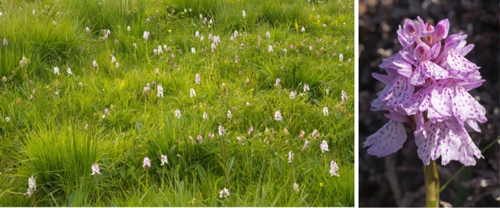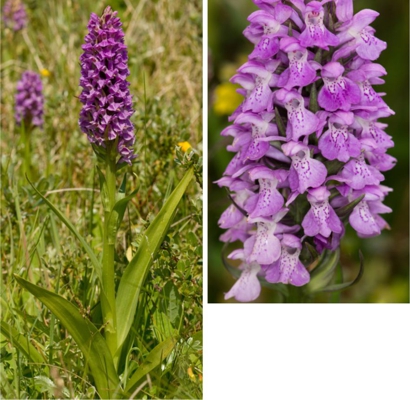Frog Orchid Dactylorhiza viridis … Lys Ysgyfarnog
June – August
Identification: 7 – 15cm. The flowers are small with a prominent elongated lip. Like the stem, they are generally green although often with variable amounts of red. The leaves are strap-shaped and always unspotted.
Similar species: None
Habitat: Grassy areas where the grass is short, rarely sand dunes
Distribution: Found only at a few sites in the south of Wales. Also occurs on Anglsey and in Denbighshire.
Conservation issues: Very local but small populations.
Notes: The colour of this orchid and its small size makes it to find. Where it is found in the Principality sometimes only one plant is present.

…………………………………………………
Common Spotted-orchid Dactylorhiza fuchsii… Tegeirian Mannog
May – July
Identification: 12 – 40cm. General appearance is similar to other members of the Genus. The overall shape of the inflorescence is cylindrical although rather triangular when the first flowers open. Plants growing in shaded places can be rather lank with fewer flowers. The general colour appears pink but closer examination will show a white background and various reddish lines and spots. Some flowers are almost white even albino. The lip is distinctly trilobed with a prominent longer, central lobe. The leaves sheath the stem and are generally, but not always, spotted.
Similar species: The overall shape of the inflorescence is similar to other orchids of the genus. The Common Spotted is the only one in Wales having a background white colour to the flowers with red/pink markings except the Heath Spotted-orchid which is invariably found on acidic soils. The pronounced sharply pointed lip is also distinctive.
Habitat: Usually on open grassy areas where it can be found with many other typically meadow flowers. Also found on grassy roadside verges sometimes in large numbers. Plants are frequently found in heavily shaded woodland, both deciduous and coniferous.
Distribution: Possibly our most widespread orchid and sometimes found abundantly.
Conservation issues: None
Notes: Like all members of the genus it hybridises freely and this can lead to difficulties in identification.

…………………………………………………
Heath Spotted-orchid Dactylorhiza maculata … Tegeirian Brych
Late May – July
Identification: 10 – 30cm. A very variable species. The inflorescence is generally triangular in shape and can be very small with only a few flowers. Flowers are generally pink, but close-up, have a white background and red/pink lines and a few dots. Many flowers have only a few red marks and some are albino and some have an attractive pink blush over all the surfaces. The lip has two large side lobes with a small central lobe. Leaves are usually spotted, sometimes blotched, are linear and found around the base of the stem.
Similar species: Most likely to be confused with the Common Spotted-orchid but the inflorescence is usually more triangular in shape with the lip having a more rounded appearance and only a small central lobe. Additionally, it is mostly found on acidic soils
Habitat: Sometimes found in large numbers on moorland where the soil is neutral to acidic.
Distribution: Has been recorded from almost every hectare in the country.
Conservation issues: None
Notes: It’s preference for moorland makes it an attractive find in these bleak environments.

…………………………………………………
Southern Marsh-orchid Dactylorhiza praetermissa … Tegeirian y Gors
June – July
Identification: 15 – 40cm. The inflorescence is a tight cluster of pink/purple flowers, and when fully open is cylindrical in shape and held on a robust stalk. The lip is rounded and apron-shaped with a small central lobe, it is marked with small darker spots and short lines. The leaves are large and pale green and generally unspotted although in most populations there will be plants with leaves marked with large spots or rings (var. junialis).
Similar species: In Wales it may found in growing with the Northern Marsh-orchid. The latter is usually smaller with much redder flowers and with the lip markedly diamond shaped.
Habitat: Can be found on a range of soils types from dunes slacks to moist pastures.
Distribution: Largely confined to the southern counties of Wales and found at its best in the Dunes of Kenfig Burrows. Has also been recorded at a few localities in the north of the country
Conservation issues: None
Notes: In some areas where it is found this species can present a wonderful display of robust plants.

…………………………………………………
Narrow-leaved Marsh-orchid Dactylorhiza traunsteinerioides …Tegeirian gors-culddail
May – June
Identification: 10 – 25cm. Plants of this a rather demure species in Wales are generally small with a cluster of about a dozen flowers forming a one-sided inflorescence. The flowers are a pink-purple colour with the lip marked with darker lines and dashes. The central lobe of the lip is distinctly elongated and often turned downwards. In keeping with its name, the leaves are grass-like and held upright.
Similar species: In Wales, there are few species with which it can be confused although like all the Marsh-orchids there is some variability which can lead to confusion.
Habitat: Plants in Wales are restricted to a few dunes and a few alkaline bogs.
Distribution: Restricted to a small number of sites in mid and north Wales such as the dunes of Ynyslas and the calcareous bogs of Anglesey. At all these sites populations are generally small.
Conservation issues: Very local and found in small numbers although populations are fairly stable.
Notes: Generally called “Pugsley’s Marsh-orchid” but the Narrow-leaved epithet seems more appropriate. Where it is found, it may be picked out in larger populations of Marsh Orchids by its delicate appearance.

…………………………………………………